The Automated Biochemical Analyzer Market is estimated to be valued at USD 1.4 billion in 2025 and is projected to reach USD 2.4 billion by 2035, registering a compound annual growth rate (CAGR) of 5.4% over the forecast period.
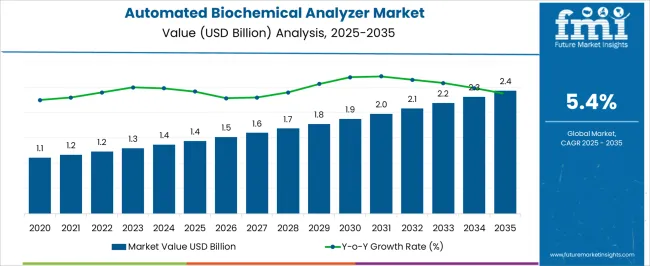
| Metric | Value |
|---|---|
| Automated Biochemical Analyzer Market Estimated Value in (2025 E) | USD 1.4 billion |
| Automated Biochemical Analyzer Market Forecast Value in (2035 F) | USD 2.4 billion |
| Forecast CAGR (2025 to 2035) | 5.4% |
The Automated Biochemical Analyzer market is being driven by increasing demand for accurate, high-throughput diagnostic solutions across healthcare settings. The current market environment reflects a growing emphasis on early disease detection, preventive healthcare, and personalized treatment protocols, which has led to greater reliance on automated analyzers. The market’s future outlook is shaped by technological advancements in automation, data integration, and improved reagent compatibility.
These factors are enabling laboratories to enhance workflow efficiency and reduce turnaround time. The ongoing rise in chronic diseases, such as diabetes and cardiovascular conditions, has further supported the market’s expansion, as continuous monitoring and biochemical analysis are critical in disease management. Increased investment in healthcare infrastructure, particularly in emerging economies, is providing further opportunities for expansion.
The ability to integrate automated systems with laboratory information management platforms is allowing for seamless operation across testing facilities As diagnostic services continue to modernize, the market is expected to expand steadily, with a focus on delivering accurate results, operational efficiency, and scalable solutions for diverse healthcare environments.
The automated biochemical analyzer market is segmented by type, application, product model, end user, and geographic regions. By type, automated biochemical analyzer market is divided into Fully-Automated Biochemical Analyzer and Semi-Automated Biochemical Analyzer. In terms of application, automated biochemical analyzer market is classified into Clinical Diagnostics, Bioreactor Byproduct Detection, Drug Development Applications, and Others.
Based on product model, automated biochemical analyzer market is segmented into Bench-Top and Floor-Standing. By end user, automated biochemical analyzer market is segmented into Hospitals, Diagnostic Centers, Pharmaceutical Companies, Biotechnology Companies, Contract Research Organizations, and Academic Research Institutes.
Regionally, the automated biochemical analyzer industry is classified into North America, Latin America, Western Europe, Eastern Europe, Balkan & Baltic Countries, Russia & Belarus, Central Asia, East Asia, South Asia & Pacific, and the Middle East & Africa.
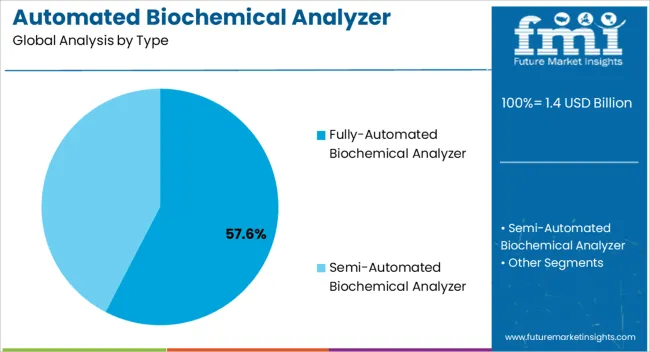
The Fully Automated Biochemical Analyzer type is projected to hold 57.60% of the Automated Biochemical Analyzer market revenue share in 2025, making it the leading type in the market. This position has been driven by its ability to perform multiple biochemical tests with minimal human intervention, thereby increasing laboratory throughput and reducing operational errors. Automation has been highly favored in clinical laboratories seeking consistent accuracy, especially in high-volume diagnostic settings.
The demand for faster results with reduced sample handling has further supported the adoption of fully automated systems. These analyzers are also being utilized to manage large-scale health screening programs, where standardization and reliability are paramount.
Laboratories are increasingly shifting to fully automated models due to their capacity for uninterrupted operation, integration with laboratory information systems, and compatibility with a broad range of reagents and testing panels The segment’s growth has been encouraged by the need for improved productivity and diagnostic precision, positioning fully automated analyzers as the preferred solution in both hospital laboratories and independent diagnostic centers.
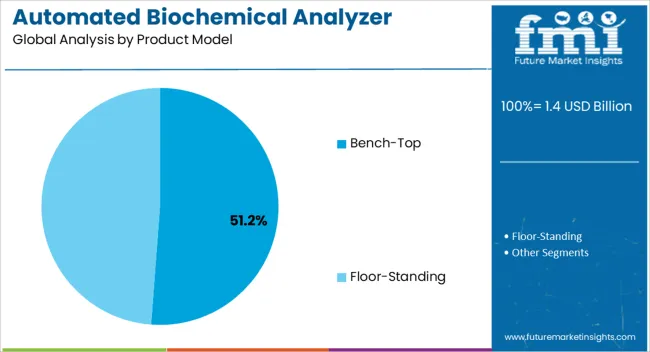
The Clinical Diagnostics application segment is expected to account for 46.80% of the Automated Biochemical Analyzer market’s revenue share in 2025, establishing it as the largest application area. The dominance of this segment has been driven by the rising demand for routine and specialized diagnostic testing required for disease management, screening, and monitoring. The increasing prevalence of metabolic disorders, infectious diseases, and chronic illnesses has reinforced the need for accurate biochemical analysis in clinical settings.
Automated analyzers have been favored for their efficiency in delivering rapid, reproducible results, which are critical for timely patient care decisions. In clinical laboratories, the integration of automation has facilitated higher sample processing capacity while ensuring quality control. Furthermore, clinical workflows are being streamlined with automated analyzers that reduce labor dependency and operational complexities.
With the emphasis on improving healthcare outcomes and minimizing diagnostic errors, automated solutions are being widely adopted by healthcare providers The segment’s continued growth is being supported by ongoing advancements in assay technologies, reagent formulations, and data connectivity, ensuring that clinical diagnostics remains at the forefront of biochemical testing.
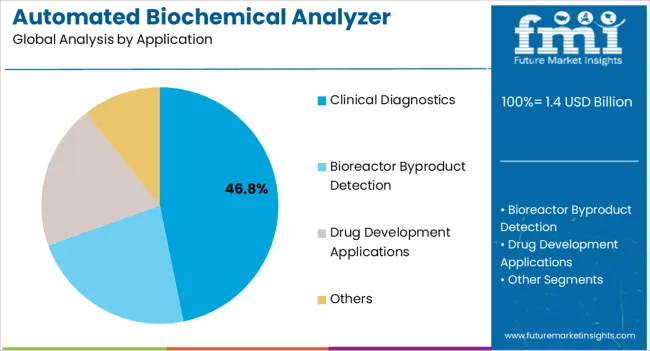
The Bench Top product model is estimated to hold 51.20% of the Automated Biochemical Analyzer market’s revenue share in 2025, making it the leading product model in the market. This preference has been driven by the model’s compact design, which allows it to be deployed in laboratories with limited space while still offering advanced testing capabilities. Bench top analyzers have been highly favored by smaller clinics, outpatient centers, and decentralized diagnostic facilities that require efficient biochemical testing without the infrastructure demands of larger systems.
Their ease of operation, simplified maintenance, and ability to integrate with laboratory workflows have further contributed to their growing adoption. The need for flexible solutions capable of delivering accurate results in constrained environments has encouraged investment in bench top analyzers. These systems also offer scalability in test menus, allowing healthcare providers to expand their diagnostic capabilities as needed.
The segment’s growth is being bolstered by advancements in reagent technologies and system interfaces, which enhance reliability and usability As diagnostic needs expand across various healthcare settings, the bench top model is expected to remain a preferred choice due to its versatility and cost-effective performance.
The automated biochemical analyzer market is segmented by type, application, product model, end user, and geographic regions. By type, automated biochemical analyzer market is divided into Fully-Automated Biochemical Analyzer and Semi-Automated Biochemical Analyzer. In terms of application, automated biochemical analyzer market is classified into Clinical Diagnostics, Bioreactor Byproduct Detection, Drug Development Applications, and Others. Based on product model, automated biochemical analyzer market is segmented into Bench-Top and Floor-Standing. By end user, automated biochemical analyzer market is segmented into Hospitals, Diagnostic Centers, Pharmaceutical Companies, Biotechnology Companies, Contract Research Organizations, and Academic Research Institutes. Regionally, the automated biochemical analyzer industry is classified into North America, Latin America, Western Europe, Eastern Europe, Balkan & Baltic Countries, Russia & Belarus, Central Asia, East Asia, South Asia & Pacific, and the Middle East & Africa.
The Fully Automated Biochemical Analyzer type is projected to hold 57.60% of the Automated Biochemical Analyzer market revenue share in 2025, making it the leading type in the market. This position has been driven by its ability to perform multiple biochemical tests with minimal human intervention, thereby increasing laboratory throughput and reducing operational errors. Automation has been highly favored in clinical laboratories seeking consistent accuracy, especially in high-volume diagnostic settings.
The demand for faster results with reduced sample handling has further supported the adoption of fully automated systems. These analyzers are also being utilized to manage large-scale health screening programs, where standardization and reliability are paramount.
Laboratories are increasingly shifting to fully automated models due to their capacity for uninterrupted operation, integration with laboratory information systems, and compatibility with a broad range of reagents and testing panels The segment’s growth has been encouraged by the need for improved productivity and diagnostic precision, positioning fully automated analyzers as the preferred solution in both hospital laboratories and independent diagnostic centers.
The Clinical Diagnostics application segment is expected to account for 46.80% of the Automated Biochemical Analyzer market’s revenue share in 2025, establishing it as the largest application area. The dominance of this segment has been driven by the rising demand for routine and specialized diagnostic testing required for disease management, screening, and monitoring. The increasing prevalence of metabolic disorders, infectious diseases, and chronic illnesses has reinforced the need for accurate biochemical analysis in clinical settings.
Automated analyzers have been favored for their efficiency in delivering rapid, reproducible results, which are critical for timely patient care decisions. In clinical laboratories, the integration of automation has facilitated higher sample processing capacity while ensuring quality control. Furthermore, clinical workflows are being streamlined with automated analyzers that reduce labor dependency and operational complexities.
With the emphasis on improving healthcare outcomes and minimizing diagnostic errors, automated solutions are being widely adopted by healthcare providers The segment’s continued growth is being supported by ongoing advancements in assay technologies, reagent formulations, and data connectivity, ensuring that clinical diagnostics remains at the forefront of biochemical testing.
The Bench Top product model is estimated to hold 51.20% of the Automated Biochemical Analyzer market’s revenue share in 2025, making it the leading product model in the market. This preference has been driven by the model’s compact design, which allows it to be deployed in laboratories with limited space while still offering advanced testing capabilities. Bench top analyzers have been highly favored by smaller clinics, outpatient centers, and decentralized diagnostic facilities that require efficient biochemical testing without the infrastructure demands of larger systems.
Their ease of operation, simplified maintenance, and ability to integrate with laboratory workflows have further contributed to their growing adoption. The need for flexible solutions capable of delivering accurate results in constrained environments has encouraged investment in bench top analyzers. These systems also offer scalability in test menus, allowing healthcare providers to expand their diagnostic capabilities as needed.
The segment’s growth is being bolstered by advancements in reagent technologies and system interfaces, which enhance reliability and usability As diagnostic needs expand across various healthcare settings, the bench top model is expected to remain a preferred choice due to its versatility and cost-effective performance.
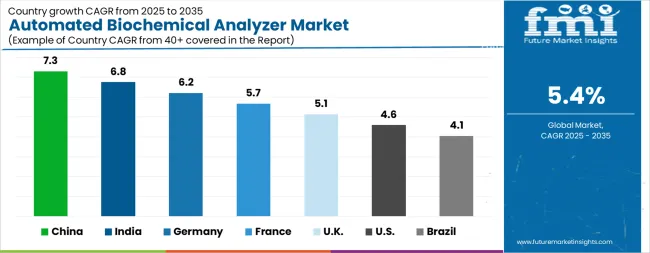
| Country | CAGR |
|---|---|
| China | 7.3% |
| India | 6.8% |
| Germany | 6.2% |
| France | 5.7% |
| UK | 5.1% |
| USA | 4.6% |
| Brazil | 4.1% |
The Automated Biochemical Analyzer Market is expected to register a CAGR of 5.4% during the forecast period, exhibiting varied country level momentum. China leads with the highest CAGR of 7.3%, followed by India at 6.8%.
Developed markets such as Germany, France, and the UK continue to expand steadily, while the USA is likely to grow at consistent rates. Brazil posts the lowest CAGR at 4.1%, yet still underscores a broadly positive trajectory for the global Automated Biochemical Analyzer Market. In 2024, Germany held a dominant revenue in the Western Europe market and is expected to grow with a CAGR of 6.2%.
The USA Automated Biochemical Analyzer Market is estimated to be valued at USD 520.1 million in 2025 and is anticipated to reach a valuation of USD 814.7 million by 2035. Sales are projected to rise at a CAGR of 4.6% over the forecast period between 2025 and 2035. While Japan and South Korea markets are estimated to be valued at USD 65.3 million and USD 46.3 million respectively in 2025.
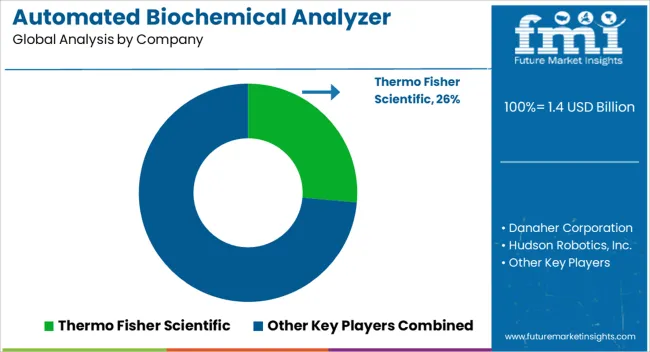
| Item | Value |
|---|---|
| Quantitative Units | USD 1.4 Billion |
| Type | Fully-Automated Biochemical Analyzer and Semi-Automated Biochemical Analyzer |
| Application | Clinical Diagnostics, Bioreactor Byproduct Detection, Drug Development Applications, and Others |
| Product Model | Bench-Top and Floor-Standing |
| End User | Hospitals, Diagnostic Centers, Pharmaceutical Companies, Biotechnology Companies, Contract Research Organizations, and Academic Research Institutes |
| Regions Covered | North America, Europe, Asia-Pacific, Latin America, Middle East & Africa |
| Country Covered | United States, Canada, Germany, France, United Kingdom, China, Japan, India, Brazil, South Africa |
| Key Companies Profiled | Thermo Fisher Scientific, Danaher Corporation, Hudson Robotics, Inc., Becton Dickinson, Agilent Technologies, Inc., Roche Diagnostics, Abbott Laboratories, and Siemens Healthineers |
The global automated biochemical analyzer market is estimated to be valued at USD 1.4 billion in 2025.
The market size for the automated biochemical analyzer market is projected to reach USD 2.4 billion by 2035.
The automated biochemical analyzer market is expected to grow at a 5.4% CAGR between 2025 and 2035.
The key product types in automated biochemical analyzer market are fully-automated biochemical analyzer and semi-automated biochemical analyzer.
In terms of application, clinical diagnostics segment to command 46.8% share in the automated biochemical analyzer market in 2025.






Our Research Products

The "Full Research Suite" delivers actionable market intel, deep dives on markets or technologies, so clients act faster, cut risk, and unlock growth.

The Leaderboard benchmarks and ranks top vendors, classifying them as Established Leaders, Leading Challengers, or Disruptors & Challengers.

Locates where complements amplify value and substitutes erode it, forecasting net impact by horizon

We deliver granular, decision-grade intel: market sizing, 5-year forecasts, pricing, adoption, usage, revenue, and operational KPIs—plus competitor tracking, regulation, and value chains—across 60 countries broadly.

Spot the shifts before they hit your P&L. We track inflection points, adoption curves, pricing moves, and ecosystem plays to show where demand is heading, why it is changing, and what to do next across high-growth markets and disruptive tech

Real-time reads of user behavior. We track shifting priorities, perceptions of today’s and next-gen services, and provider experience, then pace how fast tech moves from trial to adoption, blending buyer, consumer, and channel inputs with social signals (#WhySwitch, #UX).

Partner with our analyst team to build a custom report designed around your business priorities. From analysing market trends to assessing competitors or crafting bespoke datasets, we tailor insights to your needs.
Supplier Intelligence
Discovery & Profiling
Capacity & Footprint
Performance & Risk
Compliance & Governance
Commercial Readiness
Who Supplies Whom
Scorecards & Shortlists
Playbooks & Docs
Category Intelligence
Definition & Scope
Demand & Use Cases
Cost Drivers
Market Structure
Supply Chain Map
Trade & Policy
Operating Norms
Deliverables
Buyer Intelligence
Account Basics
Spend & Scope
Procurement Model
Vendor Requirements
Terms & Policies
Entry Strategy
Pain Points & Triggers
Outputs
Pricing Analysis
Benchmarks
Trends
Should-Cost
Indexation
Landed Cost
Commercial Terms
Deliverables
Brand Analysis
Positioning & Value Prop
Share & Presence
Customer Evidence
Go-to-Market
Digital & Reputation
Compliance & Trust
KPIs & Gaps
Outputs
Full Research Suite comprises of:
Market outlook & trends analysis
Interviews & case studies
Strategic recommendations
Vendor profiles & capabilities analysis
5-year forecasts
8 regions and 60+ country-level data splits
Market segment data splits
12 months of continuous data updates
DELIVERED AS:
PDF EXCEL ONLINE
Vapor Pressure Analyzer Market Size and Share Forecast Outlook 2025 to 2035
Automated Radionuclide Dispenser Market Size and Share Forecast Outlook 2025 to 2035
Automated Tool Grinding Systems Market Size and Share Forecast Outlook 2025 to 2035
Automated Test Equipment Market Size and Share Forecast Outlook 2025 to 2035
Automated Machine Learning Market Forecast Outlook 2025 to 2035
Automated CPR Device Market Size and Share Forecast Outlook 2025 to 2035
Video Extensometer Market Size and Share Forecast Outlook 2025 to 2035
Fluorescence Spectrophotometer Market Size and Share Forecast Outlook 2025 to 2035
Automated Compound Storage and Retrieval (ACSR) Market Size and Share Forecast Outlook 2025 to 2035
Automated People Mover Market Size and Share Forecast Outlook 2025 to 2035
Automated Colony Picking Systems Market Size and Share Forecast Outlook 2025 to 2035
Automated Truck Loading System Market Size and Share Forecast Outlook 2025 to 2035
Laboratory Grinders Market Size and Share Forecast Outlook 2025 to 2035
Ultrapycnometer Market Size and Share Forecast Outlook 2025 to 2035
Automated Microplate Handling Systems Market Size and Share Forecast Outlook 2025 to 2035
Automated Solid Phase Extraction Systems Market Size and Share Forecast Outlook 2025 to 2035
Automated Infrastructure Management Solution Market Size and Share Forecast Outlook 2025 to 2035
Automated Mineralogy Solution Market Size and Share Forecast Outlook 2025 to 2035
Global PP Closure Market Size and Share Forecast Outlook 2025 to 2035
Automated Material Handling Equipment Market Size and Share Forecast Outlook 2025 to 2035

Thank you!
You will receive an email from our Business Development Manager. Please be sure to check your SPAM/JUNK folder too.
Chat With
MaRIA